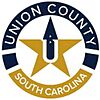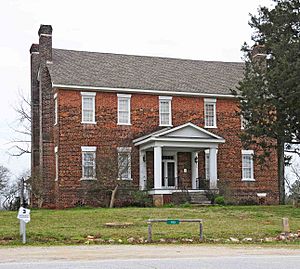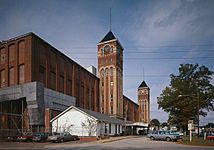Union County, South Carolina facts for kids
Quick facts for kids
Union County
|
|||
|---|---|---|---|
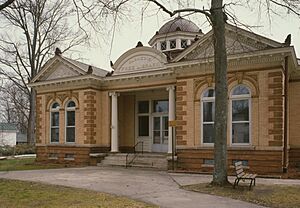
Union County Carnegie Library
|
|||
|
|||
| Motto(s):
"Gear Up"
"A Great Place To Do Business - And Live Life!" |
|||
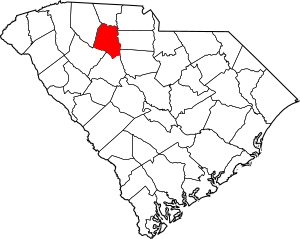
Location within the U.S. state of South Carolina
|
|||
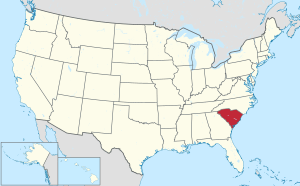 South Carolina's location within the U.S. |
|||
| Country | |||
| State | |||
| Founded | 1785 | ||
| Named for | The old Union Church | ||
| Seat | Union | ||
| Largest community | Union | ||
| Area | |||
| • Total | 515.44 sq mi (1,335.0 km2) | ||
| • Land | 513.59 sq mi (1,330.2 km2) | ||
| • Water | 1.85 sq mi (4.8 km2) 0.36% | ||
| Population
(2020)
|
|||
| • Total | 27,244 | ||
| • Estimate
(2023)
|
26,629 | ||
| • Density | 53.04/sq mi (20.48/km2) | ||
| Time zone | UTC−5 (Eastern) | ||
| • Summer (DST) | UTC−4 (EDT) | ||
| Congressional district | 5th | ||
Union County is a county in South Carolina, a state in the United States. In 2020, about 27,244 people lived here. The main town and government center is Union. Union County was created in 1785.
This county is part of the larger Spartanburg area. It's also part of the Greenville-Spartanburg-Anderson region in Upstate South Carolina.
Contents
History of Union County
Early Settlers and Native Americans
Long ago, the land that is now Union County was used by the Cherokee Native Americans. They used it as a place to hunt. Even today, you might find old arrowheads there.
The first European settlers came from Virginia and Pennsylvania around 1751. Many of them were Scots-Irish Presbyterians. They settled near a river that became Fairforest Creek. One settler supposedly said, "What a fair forest!" when he saw the trees. At that time, wild buffalo, horses, and big cats like panthers lived there. This might be how the Tyger River got its name.
More Scots-Irish families arrived in the late 1750s. They were all Presbyterians from Ireland.
First Churches and Community Names
These early settlers built the Fairforest Presbyterian Church. It was the first church in Union County. Around 1754, people settled near Brown's Creek. They built a log church that different groups shared. The county and its main town, Union, were named after this "Union" church.
Quakers also came in the mid-1750s. They settled in the southern part of the county. They built Cane Creek Church and Padgett's Creek Church. The Quakers later left in the early 1800s because they were against slavery.
Baptists arrived in 1762 and started the first Baptist church in the South Carolina upcountry. Many other Baptist churches grew from this one.
Revolutionary War Times
During the American Revolution, the area was divided. Some people, called Loyalists, supported the British. Others, called Patriots, wanted independence. This caused problems and even split churches.
After the British took Charleston in 1780, battles happened in the Carolinas. At least five battles were fought in or near Union County. These included Musgrove Mill, Fishdam, and Blackstock. Many local heroes came from Union County during this time.
After the war, the county seat was set up in Unionville, which is now Union. A courthouse was built. In 1791, a new court district was created, called the Pinckney District. Its center was in Union County, and a new town called Pinckneyville was planned.
People say Pinckneyville was almost chosen for the United States Military Academy. Instead, it was considered for a federal arsenal. But in 1799, the court system changed, and Pinckneyville lost its importance. It became a ghost town.
Life Before the Civil War
In the early 1800s, farmers in southern Union County started growing a lot of cotton. They used enslaved people to work the fields. Many large farms, called plantations, were in the county. Some of these old homes, like Rose Hill Plantation and the Cross Keys House, are still standing. Rose Hill was the home of William Henry Gist, who was the governor of South Carolina when it decided to leave the United States.
The northern part of the county had smaller farms. These farmers usually owned fewer enslaved people. Union County grew steadily but remained mostly a farming area. New stores and businesses opened in the town of Union. A famous architect, Robert Mills, designed a new courthouse and jail in 1823. The old courthouse was taken down in 1911, but the jail is still there and used today.
Civil War and Changes After
The American Civil War (1861-1865) stopped the county's growth. Many men from Union County joined the Confederate Army.
In 1861, a strange hot air balloon landed in Union County. It was piloted by Professor T.S.C. Lowe, who had flown from Ohio. Locals thought he was a spy, but he was saved by Masons in the crowd. He later helped the Union Army with air patrols.
At the end of the war in 1865, Confederate President Jefferson Davis passed through Union County. He stayed at the William Wallace house and the Cross Keys house before he was captured in Georgia.
After the war, a new system called sharecropping began. Farmers would rent land and pay with a share of their crops. This replaced slavery. During this time, there were many challenges and conflicts in the county.
In the 1890s, the Industrial Revolution came to Union County. Businessmen started building textile mills, which made fabric from cotton.
Cotton Mills and New Industries
The first cotton mill was built in Lockhart around 1894. More mills followed in Union and Jonesville. Around 1900, a mill was built west of Union, and the town of Buffalo grew up around it.
Mill workers often lived in houses owned by the company and bought food from the company store. Many workers came from the mountains of North Carolina, where farming was hard.
In 1897, some parts of Union County became part of Cherokee County.
The early 1900s brought more progress. Roads were paved, and cars became common. New businesses opened in Union.
The Great Depression in the 1930s was hard for mill workers, who earned less money. But farmers in the countryside didn't suffer as much because they grew their own food. The government bought some worn-out farmland in southern Union County and created the Sumter National Forest. Government programs like the CCC helped many people find work. They improved water systems, sewers, and roads.
During World War II, many Union County residents joined the military. After the war, cars changed how mill workers lived. They no longer had to live right next to the mills.
Union County Today
After World War II, new industries like Torrington and Sonoco came to Union County. But even in 1970, most of the county's economy was still about textiles.
In 1955, a new road, U.S. Route 176 bypass, was built. This road became a hub for new businesses, shopping centers, and restaurants. In the 1980s, many textile factories in Union County started closing and moving to other countries. By the 1990s, the textile industry was mostly gone. This left a big gap in the county's economy and identity.
In recent years, new types of industries have started in Union County. These new businesses are helping the county grow in different ways.
Geography of Union County
Union County covers about 515 square miles. Most of this is land, with a small amount of water.
Protected Natural Areas
- Sumter National Forest (part of it is in Union County)
- Rose Hill Plantation State Historic Site
- Sumter National Forest - Enoree Ranger District
- Thurmond Tract Wildlife Management Area
- Wild Turkey Management Demonstration Area
Major Rivers and Lakes
Neighboring Counties
Union County shares borders with these counties:
- Cherokee County – to the north
- York County – to the northeast
- Chester County – to the east
- Fairfield County – to the southeast
- Newberry County – to the south
- Laurens County – to the southwest
- Spartanburg County – to the northwest
Main Roads
 US 176
US 176


 US 176 Conn.
US 176 Conn. SC 9
SC 9


 SC 9 Conn.
SC 9 Conn. SC 18
SC 18


 SC 18 Truck
SC 18 Truck SC 49
SC 49


 SC 49 Conn.
SC 49 Conn.


 SC 49 Truck
SC 49 Truck SC 72
SC 72 SC 105
SC 105 SC 114
SC 114 SC 215
SC 215


 SC 215 Conn.
SC 215 Conn.
People of Union County
| Historical population | |||
|---|---|---|---|
| Census | Pop. | %± | |
| 1790 | 7,693 | — | |
| 1800 | 10,237 | 33.1% | |
| 1810 | 10,995 | 7.4% | |
| 1820 | 14,126 | 28.5% | |
| 1830 | 17,906 | 26.8% | |
| 1840 | 18,936 | 5.8% | |
| 1850 | 19,852 | 4.8% | |
| 1860 | 19,635 | −1.1% | |
| 1870 | 19,248 | −2.0% | |
| 1880 | 24,080 | 25.1% | |
| 1890 | 25,363 | 5.3% | |
| 1900 | 25,501 | 0.5% | |
| 1910 | 29,911 | 17.3% | |
| 1920 | 30,372 | 1.5% | |
| 1930 | 30,920 | 1.8% | |
| 1940 | 31,360 | 1.4% | |
| 1950 | 31,334 | −0.1% | |
| 1960 | 30,015 | −4.2% | |
| 1970 | 29,230 | −2.6% | |
| 1980 | 30,751 | 5.2% | |
| 1990 | 30,337 | −1.3% | |
| 2000 | 29,881 | −1.5% | |
| 2010 | 28,961 | −3.1% | |
| 2020 | 27,244 | −5.9% | |
| 2023 (est.) | 26,629 | −8.1% | |
| U.S. Decennial Census 1790–1960 1900–1990 1990–2000 2010 2020 |
|||
Population in 2020
In 2020, the census counted 27,244 people living in Union County. There were 11,432 households and 7,701 families.
| Race | Number of People | Percentage |
|---|---|---|
| White (not Hispanic) | 17,279 | 63.42% |
| Black or African American (not Hispanic) | 8,435 | 30.96% |
| Native American | 56 | 0.21% |
| Asian | 78 | 0.29% |
| Pacific Islander | 3 | 0.01% |
| Other/Mixed | 955 | 3.51% |
| Hispanic or Latino | 438 | 1.61% |
Population in 2010
In 2010, there were 28,961 people in the county. About 66.6% were white, and 31.3% were Black or African American. About 1% of the population was Hispanic or Latino. The average age of people in the county was 41.9 years.
The average income for a household was about $33,470. About 20.1% of the people lived below the poverty line.
Economy of Union County
In 2022, the total value of goods and services produced in Union County was about $822.7 million.
Some of the biggest employers in the county (as of April 2024) include:
- Adecco Staffing
- CSL Plasma
- Dollar General
- Gestamp
- Milliken & Company
- Sonoco
- Spartanburg Regional Healthcare System
- Timken Company
- University of South Carolina Union
- Walmart
Education in Union County
Students in Union County go to schools run by Union County Schools. There are seven public schools for about 4,500 students. This includes one high school, three elementary schools (Kindergarten to 5th grade), two K-8 schools, and one middle school (6th to 8th grade).
In the past, the county had three high schools: Union High School, Jonesville High School, and Lockhart High School. Now, Jonesville and Lockhart High Schools have closed. All students go to the new Union County High School.
The Union County High School Yellow Jackets Football team has won several state championships. They won in 1990, 1995, 1999, 2000, and 2002.
The Junior ROTC program at Union County High School is very special. It is one of only three teams in the whole country to go to The George C. Marshall Leadership and Academic Bowl in Washington, D.C., for four years in a row.
Union County is also home to a branch of the University of South Carolina. The University of South Carolina Union campus opened in 1965. It offers courses that count towards degrees at the main University of South Carolina and other colleges. About 300 to 400 students attend each semester.
The Union County's Carnegie Library was named the "Best Small Library in America" in 2009 by Library Journal.
Communities in Union County
City
- Union (This is the main town and county seat)
Towns
Census-Designated Places
These are areas that are like towns but not officially incorporated.
- Buffalo
- Monarch Mill
Other Communities
These are smaller, unincorporated communities:
- Cross Keys
- Santuc
- Fish Dam
- Bogansville
- Goshen Hill
- Pinckney
Notable People from Union County
- John Duff (around 1750-1799), a frontiersman and soldier in the Revolutionary War.
- William Henry Gist (1807–1874), who served as the governor of South Carolina from 1858 to 1860.
- States Rights Gist (1831–1864), a general for the Confederate side in the Civil War.
- John William Pearson (1808–1864), a businessman and Confederate soldier.
- Howard Franklin Jeter (born 1947), a retired diplomat who worked for the United States government.
Images for kids
See also
 In Spanish: Condado de Union (Carolina del Sur) para niños
In Spanish: Condado de Union (Carolina del Sur) para niños



